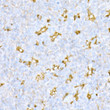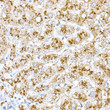| Host: | Rabbit |
| Applications: | WB/IHC-P/ELISA |
| Reactivity: | Human/Mouse/Rat |
| Note: | STRICTLY FOR FURTHER SCIENTIFIC RESEARCH USE ONLY (RUO). MUST NOT TO BE USED IN DIAGNOSTIC OR THERAPEUTIC APPLICATIONS. |
| Clonality : | Polyclonal |
| Conjugation: | Unconjugated |
| Isotype: | IgG |
| Formulation: | PBS with 0.09% Sodium Azide, 50% Glycerol, pH 7.3. |
| Purification: | Affinity purification |
| Concentration: | Lot specific |
| Dilution Range: | WB:1:500-1:1000IHC-P:1:50-1:200ELISA:Recommended starting concentration is 1 Mu g/mL. Please optimize the concentration based on your specific assay requirements. |
| Storage Instruction: | Store at-20°C for up to 1 year from the date of receipt, and avoid repeat freeze-thaw cycles. |
| Gene Symbol: | CTSD |
| Gene ID: | 1509 |
| Uniprot ID: | CATD_HUMAN |
| Immunogen Region: | 21-249 |
| Specificity: | Recombinant fusion protein containing a sequence corresponding to amino acids 21-249 of human Cathepsin D (NP_001900.1). |
| Immunogen Sequence: | LVRIPLHKFTSIRRTMSEVG GSVEDLIAKGPVSKYSQAVP AVTEGPIPEVLKNYMDAQYY GEIGIGTPPQCFTVVFDTGS SNLWVPSIHCKLLDIACWIH HKYNSDKSSTYVKNGTSFDI HYGSGSLSGYLSQDTVSVPC QSASSASALGGVKVERQVFG EATKQPGITFIAAKFDGILG MAYPRISVNNVLPVFDNLMQ QKLVDQNIFSFYLSRDPDAQ PGGELMLGG |
| Tissue Specificity | Expressed in the aorta extracellular space (at protein level). Expressed in liver (at protein level). |
| Post Translational Modifications | N- and O-glycosylated. Undergoes proteolytic cleavage and activation by ADAM30. As well as the major heavy chain which starts at Leu-169, 2 minor forms starting at Gly-170 and Gly-171 have been identified. An additional form starting at Ala-168 has also been identified. |
| Function | Acid protease active in intracellular protein breakdown. Plays a role in APP processing following cleavage and activation by ADAM30 which leads to APP degradation. Involved in the pathogenesis of several diseases such as breast cancer and possibly Alzheimer disease. |
| Protein Name | Cathepsin D Cleaved Into - Cathepsin D Light Chain - Cathepsin D Heavy Chain |
| Database Links | Reactome: R-HSA-1442490Reactome: R-HSA-2022377Reactome: R-HSA-2132295Reactome: R-HSA-6798695Reactome: R-HSA-77387Reactome: R-HSA-9018519 |
| Cellular Localisation | LysosomeMelanosomeSecretedExtracellular SpaceIdentified By Mass Spectrometry In Melanosome Fractions From Stage I To Stage IvIn Aortic SamplesDetected As An Extracellular Protein Loosely Bound To The Matrix |
| Alternative Antibody Names | Anti-Cathepsin D Cleaved Into - Cathepsin D Light Chain - Cathepsin D Heavy Chain antibodyAnti-CTSD antibodyAnti-CPSD antibody |
Information sourced from Uniprot.org












